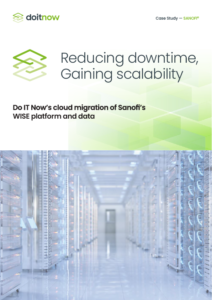The WISE environment
Sanofi®’s Worldwide Integrated Statistical Environment (WISE) Platform has been built as the company’s statistical computing environment for clinical and non-clinical R&D, CMO (chief medical office) and IA (Industrial Affairs). Procedures and data leveraging the WISE platform are GxP compliant. The platform counts 6,000+ users worldwide with 24/7 support. Today, it is used to get authorizations from health authorities to put new drugs or vaccines on the market. As such, WISE is a critical tool in the race to submissions and needs to ensure GxP1 compliancy. After more than 10 years in operation, the WISE platform needed an upgrade in order to deliver the level of service required by Sanofi.
The challenge
The WISE platform had about 200 servers and a large Lustre file system configuration to store data requiring fast access. This infrastructure design enabled WISE to fulfil the growing needs of an increasing number of users for many years. In time the platform had become increasingly strategic and any service interruption would have had serious impact on the work of thousands of employees as well as business repercussions.
To reduce downtime and improve stability, Sanofi decided to replace the WISE infrastructure on premises with a cloud infrastructure based on Amazon Web Services (AWS). By migrating to the cloud, Sanofi would gain more agility, new hardware and services that answer better to the needs of the users. The cloud would provide significantly more computational power for new applications (genomics, AI/ML algorithms) or to process ever growing data sets.
The approach
Sanofi’s infrastructure migration project to AWS, started in March of 2021 and went live in February of 2022. It consisted of three main phases:
- Architecture definition
- Infrastructure implementation
- Data migration to the cloud
Architecture Definition. The Do IT Now team adopted the “lift and shift” approach which allows the migration of applications and associated data to the cloud with minimal or no changes. However for Sanofi, this wasn’t 100% possible. Some of the technologies the company used weren’t available in the cloud, some weren’t secure and some were no longer supported by the vendors. Changes in the architecture design were made to avoid any single point of failure and improve the platform robustness. Do IT Now also ensured that Sanofi lightened the load from its team by opting for Amazon Relational Database Service (RDS) to manage databases, including backups and security.
Infrastructure definition. Do IT Now put in place more than 350 new servers and systems for which the team adopted a DevOps methodology enabling all infrastructure to be created and deployed by writing and executing code, leveraging Terraform and Ansible technologies. Automation helped eliminate human error, resulting in faster and improved reliability. DevOps allowed for easier duplication of a single configuration, which helped the team perform tests and qualifications of applications quicker. The DevOps methodology was also crucial in creating the optimal production environment, allowing the team to set up multiple environments for dedicated purposes. As a result, Sanofi shifted from manual on-premises infrastructure installation to automatic installation in the cloud.
Data Migration. The data that had to be transferred contained Sanofi’s highly sensitive clinical studies information. To speed up the transfer of this large amount of files (200 TB), Do IT Now engaged the services of AWS Snowball, a data migration device that delivers computing and storage capabilities to the customer’s edge environment. Once the data had been transferred on premises on the Snowball, the device was shipped by UPS to an AWS data center. There, AWS unpacked the device and transferred the data to the cloud. Do IT Now also developed customized tools to validate the quality of the transfer and make sure that each file was accounted for, metadata checks and integrity checks were performed on more than 30 million files.
Impact and results
No downtime. The WISE platform went from experiencing several outages per month to having zero downtimes following the migration. Thanks to a well thought out plan, Do IT Now completed the data transfer in two months, with the final leg of the project concluded over a weekend. This meant that on Friday WISE users were working on premises and by Monday they were working in the cloud without registering any difference in the interface or the application.
More compute. Sanofi has benefited from being able to harness double the compute power as Do IT Now adapts its service offering to the needs of its users by leveraging cloud flexibility. By partnering with Do IT Now, Sanofi is now able to leverage 10 times more compute power if needed.
Superior maintenance and support. Sanofi is using the services of Do IT Now to monitor the platform, perform service requests and provide user support. Sanofi choose Do IT Now because of its extensive experience and understanding of high performance computing (HPC) technologies. Compared to traditional IT services, Do IT Now has the expertise to evolve Sanofi’s architecture and manage it more efficiently.
Third-party expertise. Do IT Now’s partnership with Bright Computing was instrumental in helping the company deploy the WISE platform in the cloud. Do IT Now has leveraged Bright Computing’s cluster management software, which has accelerated time to value, reduced complexity and boosted


